



Nutrition and feeding
You should keep in mind that the quality of the feeds and the way in which they are fed are important in the management of disease. Aspects relating to nutrition in the lactating sow are dealt with in chapter 8 Nutrition. In the dry sow on the day of weaning three quarters of the daily lactation feed should be given prior to actual removal of the sow from the farrowing house and the remainder given later on that day. The sow should be given the opportunity to eat the same amount of food on the three days post weaning as she ate during late lactation. This will ensure that she does not become catabolic (a negative energy state) with an extended weaning to mating interval and subsequent infertility. Such diets should contain at least 14MJ DE/kg 16 % protein and 1.0 - 1.1% lysine, particularly if a lean genotype is being used. Immediately after mating, feed levels should be held at 2kg for the first 48 to 72 hours and then the sow fed to body condition. Provided energy levels are not excessive in the first 3 days post-mating then it is advantageous to feed the sow to body condition using a dry sow ration over the next 21 days with 3kg or more per day.
Many farms today feed separate lactating and dry sow rations. The latter with digestible energy ranging from 13 to 13.6MJ DE/kg and protein levels of 13 to 14%. It is beneficial from 3-21 days post mating to optimise feed intake relative to the sows demand since this will satisfy the nutritional requirements for the development of the placenta. This is pertinent where farms have variable weights and quality of piglets at birth. The development of the placenta in the first 12 to 25 days post mating helps to determine the quality of the piglet at the end of the pregnancy. A small placenta will contribute towards a small pig. The availability and intake of feed in this respect is important, for example where sows are fed in groups. If there is a shortage of trough space, nutritional insufficiencies can occur in the under-privileged females. During the pregnancy period the sow should be fed to body condition but also to satisfy the environmental needs. Thus it is difficult to lay down specific levels of feed intake per day, they must be determined by the stockperson. The body condition of the sow can be assessed on a numerical rating of 1 to 5 and to do this the flat of the hand should be placed over the back bone just forward of the root of the tail and rolled laterally side to side. The condition of the sow can then be scored Fig.7-3.
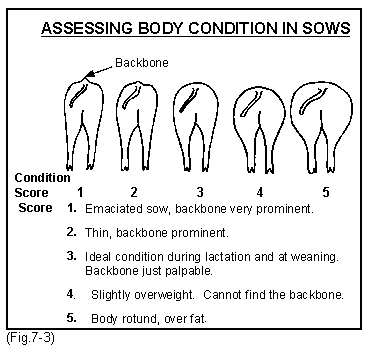
Photo's of sows scoring from 2 to 5.
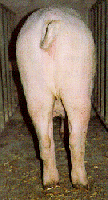 |
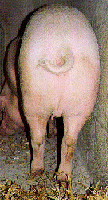 |
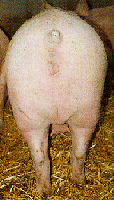 |
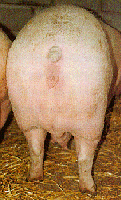 |
Score 2 |
Score 3 |
Score 4 |
Score 5 |
As a guideline sows approaching the point of weaning should score around 3. This should rise to 3 1/2 or possibly 4 in older sows by the time of the next farrowing. Sows scoring 2 1/2 or less are moving into a problem area. If more than 5% of sows at any one time score 2 1/2 or less then feeding levels are wrong. If sows are allowed to farrow with a score of less than 3 there will be insufficient fat reserves to maintain lactation and they will use muscle as a source of energy. Such sows are then in danger of developing the thin sow syndrome, being unable to maintain body condition with the demands of lactation.
In outdoor herds it is important that all sows should score over 3 before the onset of winter. It is difficult to improve body condition in cold weather. Feed levels should be higher during winter than in spring or summer.
Additional Reading
For additional information on Assessing Sow Body Condition read the article in the Feed and Nutrition area of the site.







